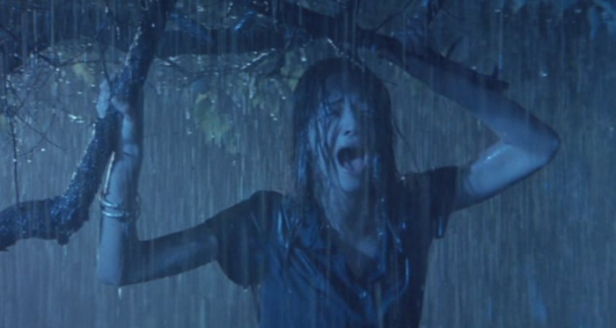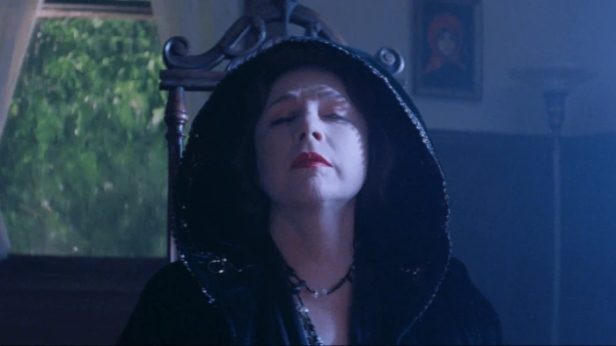Dario Argento’s 12th feature as director, his first full length film shot entirely outside Italy after his half of the anthology Due occhi diabolici/Two Evil Eyes (1990) made with George A. Romero, plays better today than it did in 1993. Coming on the back of a run of films regarded by many as Argento at his peak, from his debut L’uccello dalle piume di cristallo/The Bird With the Crystal Plumage (1970) to Opera (1987), it felt like a disappointment at the time, a step down from his usual standard. But while it’s very far from prime Argento, today it looks and feels like a much better film than one remembered it to be.
The biggest let-down is, inevitably the script. co-written by Argento with American horror novelist and editor T.E.D. Klein. The story is unnecessarily convoluted and makes little sense, but when did that ever stop us enjoying an Argento film? His work rarely made much sense, and one might argue that he was at his very best when freed from the need to worry about trifles like logic and was just able to concentrate on the mood and the visuals, the things he did best. The story here is that of Aura Petrescu (Argento’s daughter Asia, her first appearance in one of her father’s films, though she’d been in two that he’d produced, Dèmoni 2/Demons 2 (1987) and La chiesa/The Church (1989)), a young Romanian woman suffering from anorexia and other psychiatric disorders who is rescued from throwing herself off a bridge by recovering addict and television copywriter David Parsons (Christopher Rydell).

She’s returned to the home of her parents, Adriana (Piper Laurie) and Stefan (Dominique Serrand) and that night witnesses the latest murders by “The Head Hunter,” a serial killer who only strikes during storms and uses an electric-powered wire garrotte. The victims this time are her parents, killed after Adriana, a fake medium, has presided over a séance for the family of a previous victim. Aura moves in with David and are both are unaware that the killer lives in one of the neighbouring houses. Aura is menaced by her creepy and obsessive psychologist Dr Judd (Frederic Forrest) and she and David join forces to investigate The Head Hunter as the bodies continue to pile up, most of the victims being doctors or nurses. A fatal car crash seems to implicate Judd as the killer but the real culprit is a lot closer to home and is probably the last person that Aura would ever have suspected…
One of the worst one can say about many of the films in the latter half of Argento’s career is that they just don’t feel like his work at all. Trauma at least has plenty of the old madness, the wild flair and credulity-straining eccentricates and the dizzying camerawork that we’d grown to love to connect it with his golden years and while it’s definitely a step down even from the lunatic Phenomena (1985), it holds up a lot better than some of what was still to come. There are plenty of things that don’t work – a bland Minneapolis is no replacement for Argento’s former stamping grounds in Rome, Turin, Berlin or Parma; some of the special effects, created by Tom Savini, are below par (the still screaming head of disgraced doctor Lloyd (Brad Dourif) as it plummets down a lift shaft is particularly poorly done); and some of the performances are very ropey. Asia Argento isn’t helped by the fact that her character is more annoying than sympathetic, but there was no excuse for the terrible performances of Laurie and Forrest who reportedly couldn’t take the film seriously and it very much shows.

Elsewhere, the script is weak, meandering and suggests that neither Argento nor Klein actually knew what anorexia was (Aura is suffering bulimia rather than anorexia and sone of their pronouncements on the nature of the disorder are dubious in the extreme) and it again finds Argento going over ground already well explored in previous films. The idea that the lead character sees something crucial early on that eventually leads to the solving of the mystery was something he’d done many times before, right back to The Bird with the Crystal Plumage in fact and the final sequence is virtually a rerun of the closing moments of Profondo rosso/Deep Red (1975). Trauma also started that disquieting habit of Argento filming his own daughter in various states of undress, something that would become pronounced and unsettling in later films.
But what it does right, it does so in the flamboyant style that we’ve come to expect. Argento plays fair with that half-remembered clue (it’s right there near the start of the film plain as day) and some of the set-pieces are up to his usual standard. Adriana’s bogus séance is a highlight, with Argento’s typical restless cameras roving around the room as a storm rages outside, leading to an atmospheric encounter with The Head Hunter in the rain. Pino Donaggio’s score (he was replacing Argento’s long-time musical collaborators Goblin who the American producers Chris Beckman and David Pashfelt weren’t sufficiently well known) is pretty but undistinguished and Is in danger of making Trauma feel rather like an Argento pastiche made by Brian De Palma, who the composer had also worked with in recent years.

Savini claimed that Argento had decided to tone down some of the film’s gore, requiring the removal of some of his work, including a pre-credits scene in which the make-up man himself would have been decapitated in an accident, giving the killer a very different motivation for their crimes. But it’s still a pretty violent and grizzly film that required several cuts to a foreign release version and a further six seconds from that by the British Board of Film Censors (cuts later waived for DVD release).
Argento and his daughter would return to Italy for their next film, La sindrome di Stendhal/The Stendahl Syndrome (1996) and he would remain in Italy for the rest of his career, leaving Trauma a slightly odd entry in his filmography. One suspects that it would have been even more atmospheric had Argento been on home turf (no offence to the good people of Minneapolis, but it’s not the most exciting of locations) but as it stands, Trauma is a flawed but likable addition to his body of work and certainly sits head and shoulders above the likes of the subsequent Il fantasma dell’opera/The Phantom of the Opera (1998), La terza madre/The Third Mother (2007), Giallo (2009) and the appalling Dracula (2012). Which, admittedly, is damning with faint praise but on its own terms, Trauma now looks like an altogether better film that one might remember it to be.
After Inferno, his films became repetitive. His latest Black Glasses follows the same misogynistic Argento path of terrorizing and graphically murdering women, theme that he’s obsessed with. The one diversion, Dracula, was awful with cartoony CGI. Trauma comes across as an Argento movie made by another director.
LikeLiked by 1 person